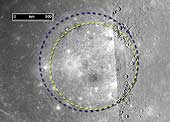|
COMETS EARTH JUPITER KUIPER BELT MARS MERCURY METEORITES NEPTUNE OORT CLOUD PLUTO SATURN SOLAR SYSTEM SPACE SUN URANUS VENUS ORDER PRINTS
PHOTO CATEGORIES SCIENCEVIEWS AMERICAN INDIAN AMPHIBIANS BIRDS BUGS FINE ART FOSSILS THE ISLANDS HISTORICAL PHOTOS MAMMALS OTHER PARKS PLANTS RELIGIOUS REPTILES SCIENCEVIEWS PRINTS
|
Related Documents
Download Options
This image shows details of the Caloris basin, one of the largest impact basins in the solar system. Caloris was discovered in 1974 from the Mariner 10 images, but when Mariner 10 flew by Mercury, only the eastern half of the basin was in daylight. During its first flyby of Mercury, on January 14, 2008, the MESSENGER spacecraft was able to snap the first high-resolution images of the western half of the basin. This image is a compilation of pictures from the Mariner 10 mission (right portion of the image) and images from MESSENGER's Narrow Angle Camera (NAC), part of the Mercury Dual Imaging System (left portion of the image). When Mariner 10 imaged the Caloris basin, the lighting conditions were very different from those experienced by MESSENGER, as is evidenced by the visible seam created when images from both missions are mosaicked together. Despite the different lighting conditions, the MESSENGER images show that the Caloris basin is even larger than previously believed. On the basis of images from Mariner 10, the rim of the Caloris structure was estimated at about 1300 km (about 800 miles) in diameter, shown as a yellow dotted line in this image. MESSENGER's images, which allow the entire Caloris basin to be seen at high-resolution for the first time, indicate that the basin rim, shown as a blue dotted line in the image, is actually closer to 1550 kilometers (about 960 miles) in diameter. Understanding the formation of this giant basin will provide insight into the e arly history of major impacts in the inner Solar System, with implications not just for Mercury, but for all the planets, including Earth. |
